- Home
- Prelims
- Mains
- Current Affairs
- Study Materials
- Test Series
Dec 31, 2021
BIHAR GOVT INITIATES STEPS TO STABILIZE POPULATION
Recently, the government of Bihar decided to sterilize nilgais to control their increasing population in the state.
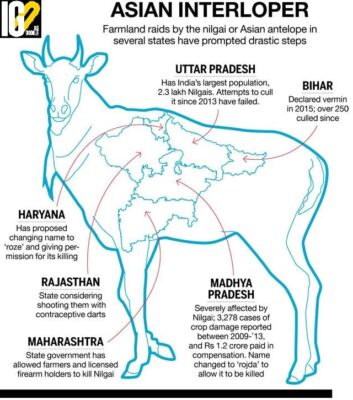 Nilgai (bluebuck)
Nilgai (bluebuck)
 Sankalp Smarak:
Sankalp Smarak:
 Konark sun temple
Konark sun temple
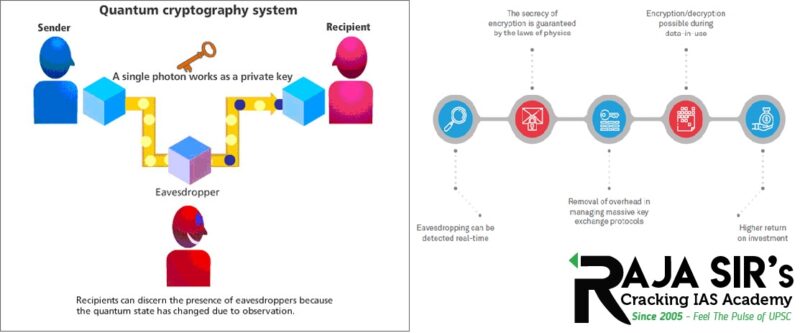 Quantum Cryptography:
Quantum Cryptography:

 James Webb Space Telescope (JWST)
James Webb Space Telescope (JWST)

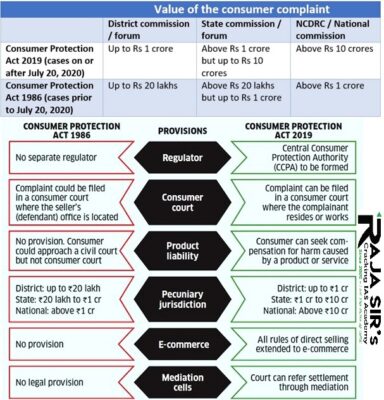 Background:
Background:
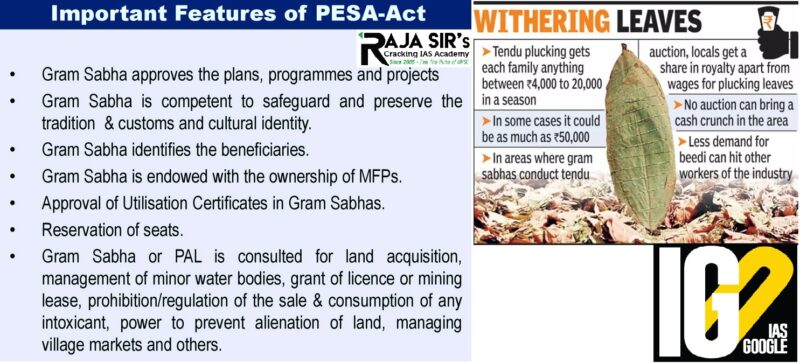 The reason for protest:
The reason for protest:
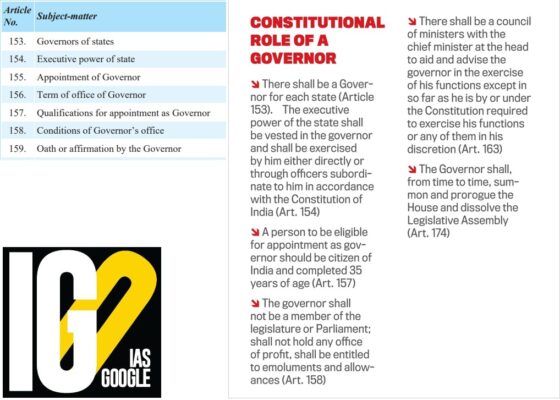 Governor
Governor
 Electoral bonds
Electoral bonds
 Corbevax:
Corbevax:
 Report:
Report:
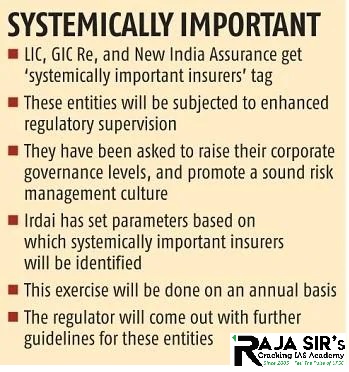 Domestic Systemically Important Insurer (D-SII)
Domestic Systemically Important Insurer (D-SII)
 London Interbank Offered Rate (LIBOR)
London Interbank Offered Rate (LIBOR)

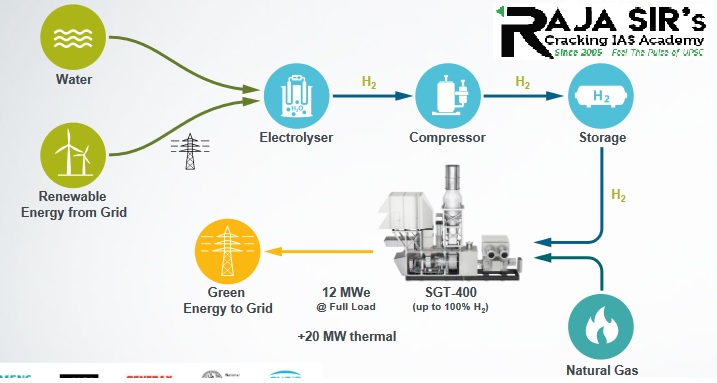 Benefits of Blending
Benefits of Blending
 Indian pangolin
Indian pangolin
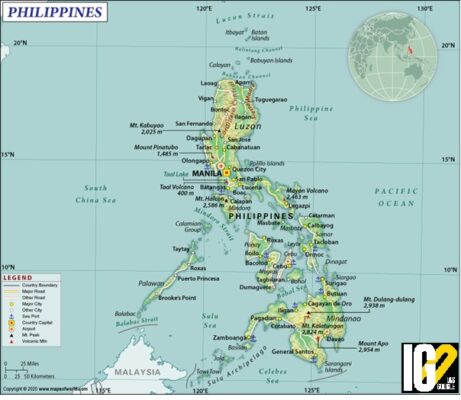 India- Philippines relations
India- Philippines relations
 Sahitya Akademi Award
Sahitya Akademi Award

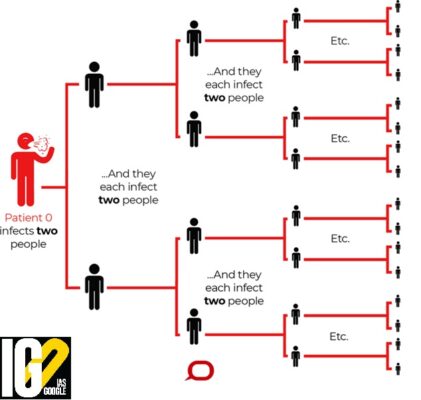 R-Value:
R-Value:
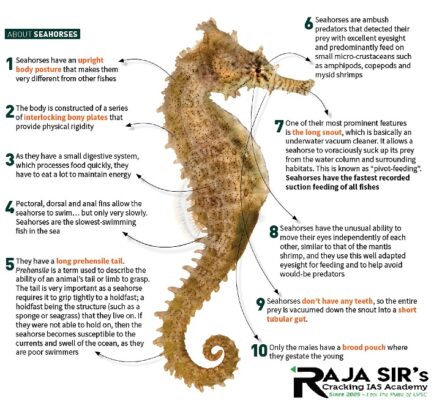 Hippocampus kuda
Hippocampus kuda
 Nilgai (bluebuck)
Nilgai (bluebuck)
- Nilgai is the largest Asian antelope.
- It is native to the Indian subcontinent.
- Physical Appearance: sloping back, a deep neck with a white patch on the throat, a short mane of hair behind and along the back ending behind the shoulder.
- It is an herbivorous animal (plant-eater). They eat grass, leaves, buds, and fruits.
- It is a diurnal (active during the day) animal that usually lives in small herds, composed of animals of only one sex.
- It releases a scent from the glands on their feet to mark the place where they take a rest during the day.
- Nilgai lives 12 to 13 years in the wild and up to 21 years in captivity.
- IUCN status: Least Concerned
- Wildlife protection act: Schedule III
- Nilgai occurs in India, Nepal, and Pakistan.
- Significant numbers occur in the Terai lowlands in the foothills of the Himalayas.
- Nilgai prefers areas with short bushes and scattered trees in scrub forests and grassy plains.
 Sankalp Smarak:
Sankalp Smarak:
- Sankalp Smarak will serve as the symbol of values enshrined by Netaji himself, “Nishtha, Kartavya aur Balidan” or “Commitment, Duty and Sacrifice” for all Indian armed forces.
- It is made in memory of the return of Netaji Subhash Chandra Bose on Indian soil at Port Blair Aerodrome on 29 Dec 1943.
- Netaji had escaped British surveillance from Kolkata on 16 Jan 1941 and came back on Indian soil after nearly three years, at Port Blair Aerodrome on 29 Dec 1943.
- This historic visit also marked a declaration of Andaman and Nicobar Islands as the “first liberated territory of India”.
- On 29 Dec 1943, a national flag was hoisted for the first time on Indian soil, at Port Blair.
- At an early age, he was strongly influenced by Swami Vivekananda’s
- He passed but the Indian Civil Service competitive examination in 1920.
- After getting deeply disturbed by the Jallianwalla Bagh massacre, he left the job in and came back too India in 1921.
- After returning to India, he was influenced by the thoughts of Mahatma Gandhi and joined the Indian National Congress.
- In 1943, the title 'Netaji' was given to Subhas Chandra Bose by German and Indian officials at the Special Bureau of India in Berlin.
- He participated in Gandhiji’s non-cooperation movement of the 1920s.
- On Gandhiji’s instructions, he started working under Deshbandhu Chittaranjan Das.
- Deshbandhu Chittaranjan Dasis acknowledged as the political Guru of Netaji Subhash Chandra Bose.
- In 1928, the Motilal Nehru Committee, appointed by the Congress, demanded Domination Status.
- But the Subhash Chandra Bose along with Jawaharlal Nehru opposed it and demanded complete independence.
- In the same year, he announced the formation of the Independence League.
- Subhas was jailed during Civil Disobedience Movement, 1930.
- Later, He was released in 1931 after the Gandhi-Irwin pact.
- When the trio of Bhagat Singh, rajguru, Sukhdev were hanged, he was unhappy. He protested against Gandhi for the Gandhi-Irwin pact.
- He also opposed the suspension of the Civil Disobedience Movement by Gandhiji.
- Later, Subhas was soon arrested again under the infamous Bengal Regulation.
- But after a year, he was released on medical grounds and sent to Europe by Britishers.
- His entry was a ban in India. But he defied and came to India. Again he was caught and jailed.
- In the General Elections of 1937, Congress came to powerin seven states and then he was released.
- He got elected as President of Congress at the Haripura Session in 1938.
- During his presidency, he talked about Economic planning and set up a National planning Committee.
- In 1939, he was re-elected, as President of Congress.
- He defeated Dr. Pattabhi Sitaramayya who had been backed by Mahatma Gandhi and the Congress Working Committee.
- Later due to differences, he resigned from the post of President of the congress and formed the Forward Bloc.
- During World War II (1941) Subhas was interned in his Calcutta home.
- However, he escapedin the disguise of a Maulavi and reached Germany under an Italian diplomatic passport with the Italian name of Orlando Mazzota.
- In 1943, at Berlin, he formed the first Indian National Army (INA) with the ‘prisoners of war’ who were Indian soldiers serving in the British Army.
- He also founded an Indian Radio Station called Azad Hind Radio in Berlin. From this radio, he used to broadcast and support Indian freedom.
- From then, he was also being called as ‘Netaji’.
- From Berlin, Subhas went to Japan at the invitation of Ras Bihari Bose.
- Here, the INA was enlarged with the addition of more soldiers and civilians.
- Here, the INA declared war against the British with the support of Japanese forces. Then, Netaji was the Chief Commander of the INA.
- By 1944, INA won areas of Imphal of Manipur. But later, due to Japanese surrender in WW-II, INA came on backfoot.
- After the Japanese surrender, he felt the need for Russian help.
- So, he left for Russia in a Japanese aircraft which unfortunately met with an accident. Subhas passed away in that accident.
 Konark sun temple
Konark sun temple
- The name Konark is made of two Sanskrit words: Kona meaning corner and arka meaning sun.
- It is a 13th-century CE Sun temple at Konark, on the coastline of
- It was built by King Narasimha Deva Iin 1244 to worship Surya, the Sun God.
- Architecture: Its architecture has all the defining elements of the Kalinga architecture.
- It includes Shikhara (crown), Jagmohana (audience hall), Natmandir (dance hall) and Vimana (tower).
- The architecture of the Konark Surya Mandir is so accurate that the day’s first light fell on the image of Surya in the sanctum sanctorum of the temple.
- Dedicated to the Hindu Sun God Surya, the temple complex has a 100-foot-high chariot with immense 24 wheels and 7 horses, all carved from stone
- This temple was called the "Black Pagoda" in European sailor accounts as early as 1676 because it looked like a great tiered tower which appeared black.
- It is declared a UNESCO world heritage site in 1984.
 Quantum Cryptography:
Quantum Cryptography:
- Quantum cryptography is a technology that uses quantum physics to secure the distribution of symmetric encryption keys.
- It works by sending photons, which are “quantum particles” of light, across an optical link.
- It allows the completion of various cryptographic tasksthat are proven to be impossible using only classical (i.e., non-quantum) communication.
- For example, it is impossible to copy data encoded in a quantum state.
- If an attempt to read the encoded data, the quantum state will be changed due to wave function collapse (no-cloning theorem).
- Quantum cryptography has the potential to encrypt data for longer periodsthan classical cryptography

- It is the best-known example of quantum cryptography.
- It is the process of using quantum communication to establish a shared key between two parties without a third-party learning anything about that key.
- A qubit (or quantum bit) is the quantum mechanical analogue of a classical bit.
- In classical computing the information is encoded in bits, where each bit can have the value zero or one whereas in quantum computing the information is encoded in qubits.
- A qubit is a two-level quantum system.
 James Webb Space Telescope (JWST)
James Webb Space Telescope (JWST)

- It is jointly developed by the USA, Canadian, and European Space Agency.
- Aim: JSWT is aimed to study the universe and space observations.
- It is the largest and most powerful telescope ever.
- It was launched in space to replace the Hubble space telescope.
- Hubble telescope was launched in 1990(by ESA and NASA) for space observation.
- Its work was universe observation.
- It is still working in the low earth orbit of the earth.
- Some major discoveries made with help of Hubble:
- Found two moons of Pluto, Nix, and Hydra.
- Helped to determine the rate of the universe's expansion
- Helped in making a 3-D map of dark matter.
- Unlike Hubble, it will not orbit the earth.
- JSWT will study the universe in the infrared. But the Hubble telescope worked on optical and ultraviolet wavelengths.
- JWST's mirror is much larger than Hubble's. So, the JSWT can look farther in space than Hubble.
- Hubble is in a much closer orbit around Earth. The JSWT will be much away from the earth.
- It is a compendium of innovations focused on agriculture featuring 70 startups supported by Atal incubation Centers (AICs) of AIM.
- It is a compilation of successful innovations by the entrepreneurial minds of India solving problems of present for future.
- It is a compendium on the innovations on technology featuring 41 innovations from Atal Tinkering Lab (ATL) of India.
- It will leverage the upcoming technologies available at ATLs to devise a solution.
- These young tinkerers will interact with the members of their community and designing a prototype in a manner that fits their needs and demands.
 Background:
Background:
- The Consumer Protection Act, 2019, provides for a three-tier quasi-judicial mechanism for redressal of consumer disputes. They are district commissions, state commissions, and national commissions (NCDRC).
- Provisions in the 2019 amendment of Consumer Protection Act of 1986 had provided that:
- Up to ₹ 50 lakh for district commissions
- ₹ 50 lakh to ₹ 2 crores for state commissions
- ₹ 2 crores or more for the national commission
- It is a quasi-judicial commission, set up in 1988 under the Consumer Protection Act of 1986.
- Head office: New Delhi.
- Composition: President and 4 members.
- Headed by a sitting or retired judge of the Supreme Court of India.
- Members: Either former High Court Judges or Secretaries to the Government of India.
 The reason for protest:
The reason for protest:
- The double taxation has hit the profits of kendu leaf organisation:
- A GST of 18 percent is imposed on kendu leaves which is against the Forest Rights Act-2006 and PESA Act-1996.
- A GST of 28 percent is imposed on bidi which is a finished product made of kendu leaf.
- Kendu leaf is an important non-wood forest product.
- It is called green gold of Odisha.
- They are the leaves of tree species Diospyros melanoxyion known by different names such as tendu, abnus, kendu, kari, tembru etc in various regions of India.
- Distribution of Tree:
- It generally grows in dry mixed deciduous forests.
- The species is abundant in Madhya Pradesh, Orissa, Maharashtra, Andhra Pradesh, Bihar, Rajasthan, Uttar Pradesh, Gujarat, Tamil Nadu, and West Bengal.
- Production: Madhya Pradesh, Chhattisgarh, Odisha, Andhra Pradesh, Jharkhand, Gujarat and Maharashtra.
- Only state government or its authorised agents can procure these leaves from the collectors or growers.
- Tree pruning or bush cutting is an important operation in the tendu leaf production process.
- Used for wrapping Bidis due to wide availability and ease with which it can be rolled.
- The leaves have agreeable flavour, flexibility, resistance to decay and capacity to retain fires.
- It provides employment to the bidi rolling rural population during off season for collection of bidi leaves.
- Tendu leaf is an important non-timber forest product (NTFP).
- The ash of the off-cuts of leaves is used in tooth powder.
- The Panchayat (Extension of the Scheduled Areas) Act, or PESA, was enacted by the Centre in 1996.
- Aim: To ensure self-governance through gram sabhas to the areas listed under the fifth schedule.
- The fifth schedule deals with the administration of the districts dominated by the Adivasi communities.
- These states include Jharkhand, Chhattisgarh, Odisha, Andhra Pradesh, Gujarat, Himachal Pradesh, Madhya Pradesh, Maharashtra, Rajasthan and Telangana.
- The Act recognises the right of tribal communities, residents of the scheduled areas, to govern themselves through their own systems of self-government.
- It also acknowledges their traditional rights over natural resources.
- Approve development plans and controlling all social sectors including the processes and personnel who implement policies.
- Decide about land acquisition, resettlement and rehabilitation of displaced persons
- Maintain a safety net over their rights and surroundings against external or internal conflicts.
- Take decisions over their customs and traditionally managed resources, and also on the minerals being excavated from their areas.
- Management of resources over jal, jangal, zameen (water, forest and land)
- Exercising control over minor forest produce, mines and minerals, markets and human resources.
- The Governor enjoys extra-ordinary power as the sole protector of the legislation in the Scheduled Areas.
- He or She can take action to amend the existing laws of the State or the Centre which are in conflict with the provisions of the PESA.
- The preamble of Section 4 of PESA Act prohibits the legislature of a State in making any law under that Part which is inconsistent with any of the features laid down in the central Act.
- PESA remains disempowered as 40% of the states under its purview have not been able to frame their rules for its implementation.
- Some states have not amended their laws to include PESA Act.
- Certain provisions in the State Panchayat Acts are not defined clearly.
- Certain subject laws and rules regarding money lending, forest and minor forest produce, mining and excise, needs to be reframed.
- Continuance of existing state laws regarding money lending, forest, excise etc.
- Incomplete transfer of ownership of minor forest produces and planning and management of minor water bodies to Gram Panchayats and Gram Sabha.
- Adequate actions have not been taken on preventing alienation of tribal lands recognized in PESA.
- The transfer of fund and functionaries to the lower-level government has not taken place after devolving statutory powers to the Gram Sabha and Panchayats.
 Governor
Governor
- The governor is the chief executive head of the state.
- But he is a nominal executive head (titular or constitutional head).
- The governor has a dual role as he acts as an agent of the central government.
- The Governor is appointed by the President, on consultation with the Chief Minister of the state concerned.
- Governor whose term has expired may be reappointed in the same state or any other state.
- The President may transfer a Governor appointed to one state to another state for the rest of the term.
- The 7th Constitutional Amendment Act of 1956 facilitated the appointment of the same person as a governor for two or more states.
- The emoluments and allowances payable to him are shared by the states in such proportion as determined by the president.
- A governor holds office for a term of five years from the date on which he enters upon his office.
- However, this term of five years is subject to the pleasure of the President.
- He should be a citizen of India.
- He should have completed the age of 35 years.
- He should be an outsider, that is he should not belong to the state where he is appointed.
- He should not be a member of either House of Parliament or a House of the state legislature.
- Executive powers.
- He can make rules for more convenient transaction of the business of a state government and for the allocation among the ministers of the said business.
- He appoints the chief minister and other ministers, general, state election commissioner, chairman and members of the state public service commission.
- He can seek any information relating to the administration of the affairs of the state.
- He can recommend the imposition of constitutional emergency in a state to the president
- He acts as the chancellor of universities in the state and appoints the vice-chancellors of universities in the state.
- He can summon or prorogue the state legislature and dissolve the state legislative assembly.
- He can address the state legislature at the commencement of the first session.
- He can appoint any member of the State legislative assembly to preside over its proceedings in the absence of the speaker and deputy speaker.
- He nominates one-sixth of the members of the state legislative council
- He can nominate one member to the state legislature assembly from the Anglo-Indian Community.
- He decides on the question of disqualification of members of the state legislature in consultation with the Election Commission.
- When a bill is sent to the governor after it is passed by state legislature, he can:
- Give his assent to the bill,
- Withhold his assent to the bill,
- Return the bill (if it is not a money bill) for reconsideration of the state legislature
- Reserve the bill for the consideration of the president.
- He can promulgate ordinances when the state legislature is not in session
- He lays the reports of the State Finance Commission, the State Public Service Commission and the Comptroller and Auditor-General.
- He sees that the Annual Financial Statement (state budget) is laid before the state legislature.
- Money bills can be introduced in the state legislature only with his prior recommendation.
- No demand for a grant can be made except on his recommendation.
- He can make advances out of the Contingency Fund of the state to meet any unforeseen expenditure.
- He constitutes a finance commission after every five years to review the financial position of the panchayats and the municipalities
- He can grant pardons, reprieves, respites and remissions of punishment or suspend, remit and commute the sentence of any person.
- He is consulted by the president while appointing the judges of the concerned state high court.
- He makes appointments, postings and promotions of the district judges in consultation with the state high court.
- He also appoints persons to the judicial service of the state (other than district judges) in consultation with the state high court and the State Public Service Commission.
 Electoral bonds
Electoral bonds
- An electoral bond is designed to be a bearer instrument like a Promissory Note.
- Aim: To address the problem of anonymous cash donations made to political parties which lead to generation of black money in the economy.
- The electoral bonds were introduced with the Finance Bill (2017).
- The bonds are similar to banknotes that are payable to the bearer on demand and are free of interest.
- The citizen or corporate can then donate the same to any eligible political party of his/her choice.
- Eligibility to purchase the bond: A citizen of India or a body incorporated in India
- Can only be encashed by political parties, which had secured at least 1 % of the votes polled in the most recent Lok Sabha or state election.
- Can be purchased for any value in multiples of Rs.1,000, Rs.10,000, Rs.10 lakhs, and Rs.1 crore from State Bank of India (SBI).
- Electoral bonds have a life of 15 days during which they can be used to make donations to registered political parties.
- The electoral bonds are available for purchase for a period of 10 days each in months of January, April, July and October.
- The donor and the party details are available with the bank, but the political party might not be aware of who the donor is (Name of the donor is not mentioned on the bond.
 Corbevax:
Corbevax:
- It is manufactured by Hyderabad-based Biological E.
- It is a protein subunit vaccine, which means that instead of the whole virus, it uses fragments of it to trigger an immune response.
- The subunit vaccine contains a harmless S protein.
- Once the immune system recognises the protein, it produces antibodies to fight a real infection when it happens.
- Molnupiravir is an oral antiviral drug.
- It is developed in collaboration by US firms Ridgeback Biotherapeutics and Merck, initially to treat influenza.
- It is a repurposed oral antiviral candidate to treat Covid patients.
- It works by introducing errors into the virus’s genetic code, which prevents replication.
- It is a recombinant nanoparticle vaccine.
- It is manufactured by Serum Institute of India (SII).
- It is also a protein subunit vaccine, but uses recombinant nanoparticle technology.
- It has been developed by US-based Novavax.
- Harmless copies of the spike protein are grown in insect cells; the protein is then extracted and assembled into virus-like nanoparticles.
- The S protein is a highly glycosylated fusion protein.
- It is made up of amino acids.
- The S protein plays a crucial role in penetrating host cells and initiating infection.
- The presence of S proteins on the coronaviruses is what gives rise to the spike-shaped protrusions found on their surface.
- Without the S protein, viruses like SARS-CoV-2 would not be able to interact with the host cells of animals and humans to cause infection.
- As a result, the S protein represents an ideal target for vaccine and antiviral research endeavors.
 Report:
Report:
- The report compiled and analysed the results of Rapid Gender Assessment surveys (RGA)
- It included 58 countries across all regions.
- It focused on five key areas:
- Participation in the workforce
- Unpaid care and domestic work
- Emotional and physical well-being
- Access to goods and services
- Relief and social protection measures.
- Women and girls disproportionately suffered the socio-economic impacts of (COVID-19), through lost jobs reduced work hours, increased intensity of care and domestic work and strains on their physical and mental health.
- 29 per cent of working mothers living with children lost their jobs compared to only 20 per cent of working men living with children.
- Young women living with children were hard-hit, with 56 per cent seeing reduced paid work hours versus only 44 per cent of young men living with children.
- Single women living with children were particularly left behind, being less than half as likely as single men living with children to receive cash relief (12 % of women vs 25 % of men).
- Women without children were also less likely to receive cash relief (8% of women vs 17% of men).
- Younger women (aged 18-24) were also less likely to receive cash relief (9% vs 21 % of men), unemployment insurance (5% vs 18% men) or support from non-profits (6 % vs 7% of men).
- Women aged 60 years and older were most likely to report receiving cash relief (12%), unemployment insurance (17%) and support from non-profits (16%).
- In addition to limited relief, unemployed women were half as likely as men to report that they are covered by unemployment insurance (7% of women vs 14% of men) in 19 countries.
- They played a key role in providing relief measures to mitigate the impacts of COVID-19.
- Women were slightly less likely than men receiving support from non-profits (9% vs 10% respectively).
- Gendered differences in non-profits’ support was substantial in Philippines (6% women vs 28% men), in Mexico (7% women vs 33% men) and in Serbia (51% women vs 69% men).
- Government cash relief was not associated with losing one’s job in most countries.
- In 25 out of 34 countries, loss of jobs had no impact on women receiving cash relief from government.
- 95 percent women in Asia and 89 per cent of women in sub-Saharan Africa earn income through informal labour, insecurity and insufficient social protection.
- UN Women is the United Nations entity dedicated to gender equality and the empowerment of women.
- Aim: To accelerate progress on meeting their needs worldwide.
- They also coordinate and promote the UN system’s work in advancing gender equality, deliberations and agreements of the 2030 Agenda.
- The entity works to position gender equality as fundamental to the Sustainable Development Goals.
- Division for the Advancement of Women (DAW)
- International Research and Training Institute for the Advancement of Women (INSTRAW)
- Office of the Special Adviser on Gender Issues and Advancement of Women (OSAGI)
- United Nations Development Fund for Women (UNIFEM)
- Women lead, participate in and benefit equally from governance systems.
- Women have income security, decent work and economic autonomy.
- All women and girls live a life free from all forms of violence.
- Women contributes in building sustainable peace and resilience, and benefit equally from the prevention of natural disasters and humanitarian action.
- To support inter-governmental bodies in the formulation of policies, global standards and norms.
- To help Member States implement these standards, and to forge effective partnerships with civil society.
- To lead and coordinate the UN system’s work on gender equality and promote accountability.
 Domestic Systemically Important Insurer (D-SII)
Domestic Systemically Important Insurer (D-SII)
- It refers to insurers of such size, market importance and domestic and global inter connectedness whose distress or failure would cause a significant dislocation in the domestic financial system.
- They are perceived as insurers that are ‘too big or too important to fail’ (TBTF).
- The parameters for identification of D-SIIs:
- The size of operations in terms of total revenue, including premium underwritten and the value of assets under management.
- Global activities across more than one jurisdiction.
- Lack of substitutability of their products or operations.
- Inter connectedness through counterparty exposure and macro-economic exposure.
- The Basel Committee on Banking Supervision issued the rules text on the assessment methodology for global systemically important banks (G-SIBs).
- In 2011, the G20 Leaders and the Financial Stability Board work on modalities to extend expeditiously the G-SIBs framework to domestic systemically important banks (D-SIBs).
- D-SIB framework requires the Reserve Bank to disclose the names of banks designated as D-SIBs and place these banks in appropriate buckets depending upon their Systemic Importance Scores (SISs).
- Based on the bucket in which a D-SIB is placed, an additional common equity requirement has to be applied to it.
- In case a foreign bank having branch presence in India is a Global Systemically Important Bank (G-SIB).
- It has to maintain additional Common Equity Tier (CET1) capital surcharge in India as applicable to it as a G-SIB and proportionate to its Risk Weighted Assets (RWAs) in India.
- Now, the global benchmark will be discarded for new contracts from 1st January 2022.
- It has already started offering ARR (alternate reference rates) -based products to customers.
 London Interbank Offered Rate (LIBOR)
London Interbank Offered Rate (LIBOR)
- LIBOR is the benchmark interest rate at which major global banks lend to one another.
- LIBOR is administered by the Intercontinental Exchange, which asks major global banks how much they would charge other banks for short-term loans.
- The rate is calculated using the Waterfall Methodology, a standardized, transaction-based, data-driven, layered method.
- LIBOR has been subject to manipulation, scandal, and methodological critique, making it less credible today as a benchmark rate.
- It is an influential interest rate that banks use to price U.S. dollar-denominated derivatives and loans.
- It’s based on the rates that large financial institutions pay each other for overnight loans.
- In the United Kingdom, SONIA replaced Libor in 2021.
- Administered by the Bank of England, SONIA reflects the average rates for overnight UK Pound-denominated loans among banks and financial institutions.

- Cropland is defined as land used for annual and perennial herbaceous crops for human consumption, forage (including hay) and biofuel.
- Perennial woody crops, permanent pastures and shifting cultivation are excluded from the definition.
- The cropland expansion is often explained as a direct consequence of the global increase in food and energy requirements due to continuing population growth.
- Cropland area across the world increased by 9 per cent and cropland net primary production (NPP) by 25 per cent from 2003-2019.
- The largest cropland expansion (34 per cent) was observed in Africa.
- Global per capita cropland area decreased by 10 per cent.
- Cropland expansion results in additional global crop production and thereby satisfies the need of the global population.
- Cropland expansion is the major cause of global biodiversity loss through the loss and fragmentation of natural habitat.
- It poses major threats to many common as well as IUCN red-listed species.
- Acceleration of cropland expansion has resulted in a significant negative impact to tropical rainforests, leading to deforestation and changes to watershed hydrology and water balance.
- Land-use intensification threatens multiple taxa of primarily farmland species due to habitat homogenization, irrigation and high inputs of agro-chemicals.
 Benefits of Blending
Benefits of Blending
- Adding hydrogen to natural gas can significantly reduce greenhouse gas emissions.
- It improves air quality by reducing Sulphur dioxide, oxides of nitrogen, and particulate emissions and displacing conventional gasoline or diesel fuels.
- It can improve the carbon intensity and sustainability of the final natural gas product delivered to consumers.
- Blending may also prove to be a viable means of delivering hydrogen produced in remote locations and extracting the hydrogen downstream near end-use applications.
- The hydrogen and natural gas mixture is used in existing appliances for heat and electricity generation.
- The energy density of hydrogen is around 33% of that of natural gas’s energy density.
- A 3% blend of hydrogen blend in a natural gas pipeline would reduce the energy content that the pipeline transports by around 2%.
- Variability in the volume of hydrogen blended into the natural gas stream would have an impact on the operation of equipment as only a narrow range of gas mixtures pass.
- Hydrogen burns faster than methane gas and the flame is also not bright while burning which could result in the risk of flame spread.
 Indian pangolin
Indian pangolin
- Indian Pangolin is a large anteater.
- They are the only mammals wholly-covered in scales (made of keratin), used as protection from predators.
- They are nocturnal and spend most of their day among rocks or in their burrows.
- During the night they leave their burrows to search for food.
- They mainly eat ants and termites.
- A terminal scale is present on the ventral side of the tail of the Indian Pangolin.
- Its sticky tongue, which is longer than its body, is specially adapted for reaching and lapping up insects in deep crevices.
- It has about 13 rows of moveable sharp scales covering its body, which are shed periodically.
- It lives in Bangladesh, Southern Nepal, Sri Lanka, India.
- It inhabits rainforest, grasslands, and barren hilly areas.
- It can live in modified habitats, so long as there are plenty of termites and ants.
- IUCN Status: Endangered
- IUCN status of Chinese and Sunda pangolins- Critically endangered
- Wildlife Protection Act: Schedule I
- Habitat degradation
- Human-wildlife conflict
- Fragmentation of forest areas due to developmental projects and encroachment by villagers.
- Poaching: International trade: For its meat and scales in East and South East Asian countries, particularly China and Vietnam.
 India- Philippines relations
India- Philippines relations
- India and the Philippines formally established diplomatic relations on 26 November 1949.
- With the launch of Look East policy, India has intensified its relationship with Philippines.
- With the Act East Policy initiated in 2014, the relationship with Philippines has diversified further into political-security; trade and industry and people-to-people realms.
- The political cooperation between India and the Philippines has been sustained since 1980s
- In 2006, two countries signed Memorandum of Understanding (MoU) on Defense and Security Cooperation.
- India and the Philippines have also begun holding regular intelligence exchange (INTELLEX)meetings on a range of sensitive issues.
- India trains Filipino foreign service officers at its Foreign Service Institute, and the both have begun conducting military training exchanges.
- The first exchange among their respective National Defense Colleges was conducted in India in 2013.
- Government of India sent an Indian Air Force flight with relief material for the victims of super typhoon ‘Haiyan’.
- India’s export to Philippines in 2021 is around 18.41 INR billion.
- Indian investment in the Philippines is mainly in the areas of textiles, IT&ITES, Infrastructure (airports), chemicals, automobiles and pharmaceuticals.
- Collaboration in the BPO sector has grown exponentially in the last ten years or so.
- India and the Philippines have signed various agreements and MoU's for cooperation in the energy sector.
- A large number of Sanskrit words is used in the local languages and the Hindu epic story of Ramayana is very popular in the Philippines.
- 36 Indian citizens have received the Ramon Magsaysay award, known as the ‘Nobel prize of Asia,’.
- Ramon Magsaysay award was instituted in memory of the former Philippine
- The Indian Council of Cultural Relations also offers two scholarships to the Filipino students for higher studies in India.
- To commemorate the 150th Birth Anniversary of Mahatma Gandhi, the Embassy of India organized various events in Manila.
- Aim: to boost indigenisation in defence manufacturing and to ensure foreign exchange savings of ₹3,000 crore a year.
- Objective-
- To make India a hub for developing and manufacturing military hardware by reducing dependency on imported hardware.
- To produce weapons and platforms that can be used by the Indian military and exported to other countries.
- It is the third list issued by defence ministry.
- First list has announced that India will stop importing 101 weapons and military platforms such as transport aircraft, light combat helicopters and sonar systems by 2024.
- Second list has restricted the import of 108 more weapons such as airborne early warning systems, tank engines, radars and next-generation corvettes.
- The list contains 2,500 imported items which have already been indigenised.
- Once the restrictions take effect, these items can be procured only from Indian industries.
- Benefit- the foreign direct investment (FDI) limit under the automatic route in the defence sector was hiked from 49% to 74% in 2020.
- Key features of DAP 2020
- Buy {Indian-IDDM (Indigenously Designed, Developed and Manufactured)}
- This category has been accorded on priority for procurement of capital equipment.
- The ‘Make’ Procedure of capital procurement has been simplified.
- There is a provision for funding up to 70% of development cost by the Government to Indian industry under Make-I category.
- Procedure for ‘Make-II’ category (Industry funded) has been introduced.
- 58 projects relating to Army, Navy & Air Force, have been accorded ‘Approval in Principle’.
- The Government has enhanced FDI in Defence Sector up to 74%through the Automatic Route and up to 100% by Government Route.
- Buy {Indian-IDDM (Indigenously Designed, Developed and Manufactured)}
- Launched-2020
- Aim-to provide development support to MSMEs/Start-ups/Industry for import substitution.
- Policy for indigenisation of components and spares used in Defence Platforms.
- Launched-2019
- Objective- to create an industry ecosystem which is able to indigenize the imported components (including alloys & special materials) and sub-assemblies for defence equipment and platform manufactured in India.
- Government has established two Defence Industrial Corridorsin Uttar Pradesh and Tamil Nadu.
- Signed- 2019
- Objective- to enhance the “After Sales Support” and operational availability of Russian origin equipment currently in service in Indian Armed Forces.
- Launched-2018
- Aim-creation of an ecosystem to foster innovation and technology development in Defence and Aerospace
- Created-2018
- Aim- to provide all necessary information including addressing queries related to investment opportunities, procedures and regulatory requirements.
- Launched-2017
- Partnership with global Original Equipment Manufacturers (OEMs).
- Aim- to seek technology transfers to set up domestic manufacturing infrastructure and supply chains.
 Sahitya Akademi Award
Sahitya Akademi Award
- It is a literary honour in India given by Sahitya Akademi.
- It is the second-highest literary honour next to a Jnanpith award.
- It is conferred on 24writers in 24 languages annually for the most outstanding books of literary merit.
- Among 24 language, 22 languages are given in Eighth Schedule and other two are English and Rajasthani language.
- Each Award carries a plaque, shawl, citation and a Cheque for Rs. One Lakh.
- The author must be of Indian nationality.
- The Award will be considered only if there is minimum of three books in the final stage of selection.
- The book should not be a translation work or abridgment.
- Established in 1954
- It was registered as a society in 1956, under the Societies Registration Act, 1860.
- Headquarter: New Delhi.
- Aim-To recognize and promote excellence in Indian writing and also acknowledge new trends.

- It was launched by the Andhra Pradesh police.
- Aim: To curb the supply side of the ganja menace and create awareness on the consequences of the illegal trade and provisions under the Narcotic Drugs and Psychotropic Substances Act, 1985.
- It was a resolution endorsing the Joint Comprehensive Plan of Action on the nuclear program of Iran.
- Joint Comprehensive Plan of Action (JCPOA) s known as the Iran nuclear deal or Iran deal.
- It is an agreement on the Iranian nuclear program.
- Aim-to promote the development of normal economic and trade contacts and cooperation with Iran.
- Concluded- 2015 by China, France, Germany, the Russian Federation, the United Kingdom, the United States, European Union and Iran.
- It sets out an inspection process and schedule while also preparing for the removal of United Nations sanctions against Iran.
- UN Member States are obligated under Article 25of the Charter of the United Nations to accept and carry out the Security Council’s decisions.
 R-Value:
R-Value:
- R-value or Reproduction number (R) value is also known as the R-factor or reproduction rate.
- R-Value is an indicator of how quickly a disease is infecting and spreading in the population.
- If R-value is 1, then it means that every infected person is passing on the infection to at least one person on average.
- Tequila is a fish species from Mexico.
- The name ‘tequila’, is derived from Tequila Volcano.
- It is endemic to Ameca River basin in west-central Mexico.
- The species was considered extinct in 2003.
- Palk Bay is a shallow water body between the southeast coast of India and Sri Lanka.
 Hippocampus kuda
Hippocampus kuda
- It is also known as the common seahorse or yellow seahorse.
- It is widely distributed throughout the Indo-Pacific region in mangroves, coastal seagrass etc.
- trimaculatus
- It is also known as a flat-faced seahorse or three-spot seahorse.
- Its natural habitat is shallow seas.
- Found in the Indo-Pacific Ocean.









 Latest News
Latest News
 General Studies
General Studies